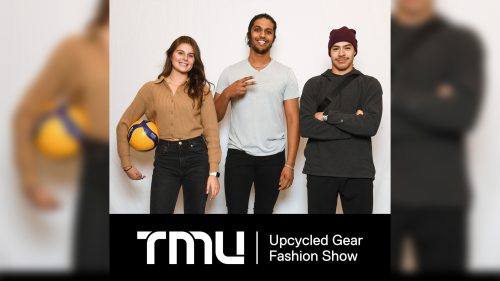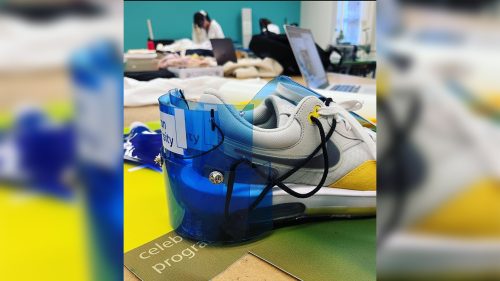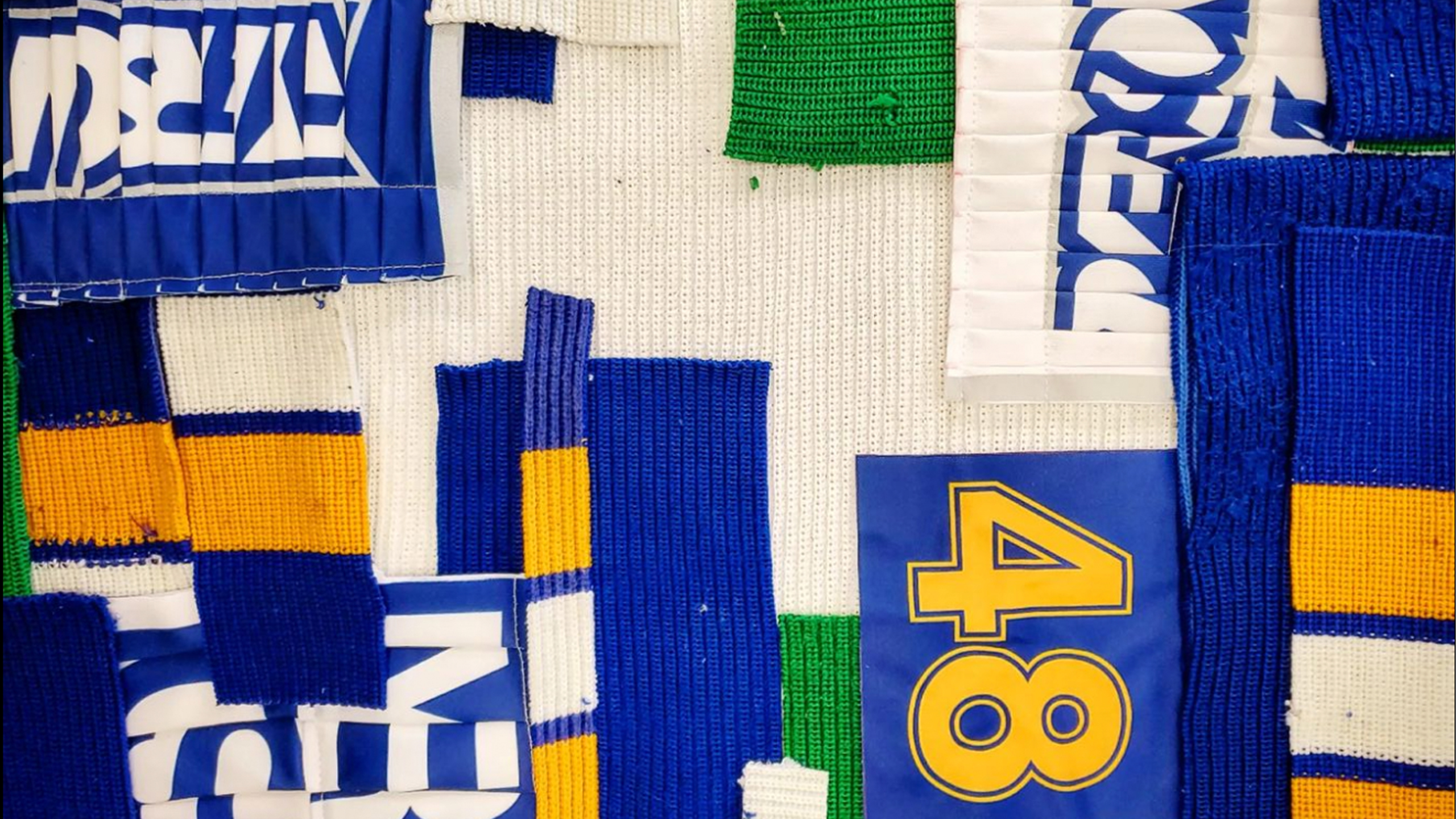By Haley Sengsavanh
In late September, boxes packed full of old athletic gear arrived on the doorsteps of 19 Toronto Metropolitan University (TMU) fashion design alumni. Inside were clusters of blue and yellow fabric, from hockey socks, cheerleading gloves to basketball jerseys. All these items had one thing in common: they were old Ryerson and Rams-branded products now considered waste. But through the TMU Upcycled Gear Fashion Show, these clothing items and gear will receive a new life in the form of 25 runway-ready outfits.
This event, which will be held at the Mattamy Athletic Centre (MAC) on Nov. 28 from 5:30 p.m. to 7:30 p.m., is part of the university’s Branded Materials Transition Project (BMTP), led by members of the TMU Athletics and Recreation department. Its goal is to reuse or upcycle all of the university’s outdated branded materials including merchandise, uniforms, apparel, letterheads and more.
The fashion show is also part of the MAC’s 10th anniversary celebrations, the university said in a written statement to The Eyeopener.
They said the fashion show aims to “honour and celebrate the legacy of the Rams and the future success of TMU Bold while shining the light on environmental sustainability.” The university reported that to date, they have prevented over 7,000 kilos of branded materials from entering landfills, with a goal to exceed 10,000 kilos by the end of 2022.
Anika Kozlowski, an assistant professor of fashion design, ethics & sustainability, was approached by TMU’s athletics department to assist with the textiles side of the BMTP initiatives. This project was a “perfect fit” for Kozlowski, she said. Not only does she have an academic background in fashion sustainability, she is also a sports enthusiast and has been upcycling since university.
“Generally you upcycle something that has no value, and the whole point is to give it value”
The fashion show is part of Kozlowski’s environmental sciences research project into upcycling. She conducted interviews with all the designers and instructed them to ship back all their leftover fabric scraps to document how much of the material was actually used.
“We’re doing research to understand upcycling more because it’s very different from a traditional fashion design process. Generally you upcycle something that has no value and the whole point is to give it value,” she said. “You’re working with materials that have stains, could be ripped or have lots of abrasion and wear.”
Alongside fashion professor Shelley Haines, Kozlowski also created an outfit to be showcased on the runway. “It’s been a long time since I’ve been involved with a fashion show, so just getting to be creative again and be a part of this was a highlight for sure,” she said.
The alumni she selected for the show are all involved in the realm of sustainability. Jessica Frankel, who graduated from TMU’s fashion design program in 2020, created her capstone project entirely out of denim from thrift stores. To create those five looks, she utilized a Japanese mending style called Boro, which patches textile scraps together using a single stitch. The result was a patchwork-looking effect.
She created a similar patchwork look for the fashion show by making her own fabric from old basketball and hockey jerseys. Out of this unique textile, Frankel created a cropped tank top and low-waisted joggers set, with zippers curving around the body that allow it to be adjusted to the wearer’s personal liking. She said the outfit was inspired by sports uniforms and Y2K fashion. “You look at this and you think TMU,” Frankel said.
Frankel hopes that the fashion show will inspire people to consider how much work went into saving the once-abandoned pieces of clothing.
“Anything you can think of that can be branded is sitting in a box, in a bunker in school,” she said. “We’re doing our part as designers to give these products new life so that they can be worn again and not in a landfill somewhere.”

Tickets for the show are available for purchase on the MAC website. Floor tickets for TMU alumni and community members cost $20 and balcony tickets for TMU students with a valid OneCard are $10. There is limited capacity on the balcony, with standing room only.
All the limited edition runway outfits will be auctioned off at a fundraising event after the show.
All the proceeds from the fashion show will go toward the TMU Bold Equity & Inclusion Award, which financially supports student athletes from equity-deserving groups.
President Mohamed Lachemi, interim provost Roberta Iannacito-Provenzano, vice-provost students, Jen McMillen and 25 TMU varsity and club team student athletes will be walking the runway, according to the university.
During the design process, the fashion design alumni had the opportunity to connect with the athletes modelling their looks and collaborate to create something authentic to them.
Frankel worked with student-athlete Alyona Ivanova, who graduated from TMU’s biomedical sciences program in 2022. She was part of the TMU figure skating team and continues to be a part of the school’s equestrian team.
Ivanova is a lifelong athlete—she grew up figure skating and competed for the Russian national team before moving to Canada. She currently works for SickKids in the neurosurgery research department.
Ivanova is also signed to Icon Models and says the show is a great opportunity for her to learn more about the fashion industry and connect with people in it. “As a figure skater, I really like performing and being on stage,” she said. “Fashion shows are also a performance in a way and you get to show off the work of great designers.”
This unique mix between sports and fashion was one of the things that initially intrigued TMU fashion design 2021 graduate Roy Luo about this event. His design process involved a lot of feedback from his models. He chose a sporty direction when creating the two outfits and matching accessories.
“I really wanted to get the perspective of the student athletes and ended up getting really inspired by the sports they played. One of them is a baseball player so I made pants that have a running baseball stitch on the seams.”

Source: @ anikazofia via Instagram
Luo’s goal when creating these garments was to incorporate as many ways of upcycling as possible. One method was de-constructing knitted items like toques into balls of yarn, which he then wove into a scarf using a loom. “A lot of knitwear is constructed in a circular and almost zero-waste way, so a piece can be made out of a single strand of yarn,” he said.
Throughout this project, Luo was also able to experiment with zero waste techniques like subtraction cutting. This method of garment-making can be applied to any tubular shape and starts with the designer drawing out the basics for the garment in a mismatched way.
Then, rather than cutting out the pattern piece itself, they cut out the negatives to create a new drape.
“A lot of knitwear is constructed in a circular and zero-waste way”
He incorporated part of this technique when creating a patchwork skirt from cut-up hockey socks.
“In subtraction cutting, you’re able to cut out circles or squares from it. Then you can put them together. It creates an interesting shape that you couldn’t conventionally get if you were trying to draft from the ground up.”
Luo believes the fashion show is making a positive impact and hopes it demonstrates the potential that upcycling has.
“There’s a lot of ideas in this project,” he said.
“The different techniques that me and my fellow designers are incorporating really shows you that there’s more than one way to create sustainable fashion.”











Leave a Reply